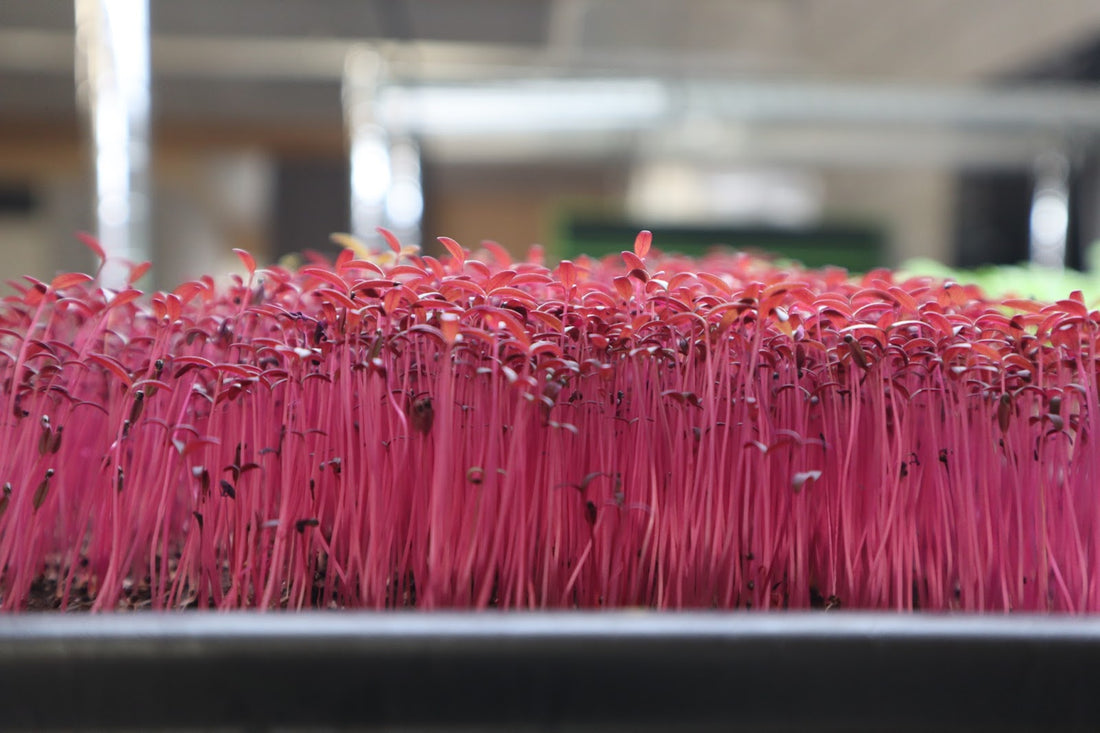
Growing Amaranth Microgreens at Home: An Easy Step-by-Step Guide
Share
Amaranth microgreens are tiny sprouts, bursting with color and flavor, which are gaining popularity not only for their appealing appearance but also for their health benefits. In this article, we'll explore what exactly amaranth microgreens are, how to cultivate and incorporate them into a daily diet, and the advantages they offer in terms of nutrition and taste. Let’s discover their potential in the context of sustainable agriculture and how they can contribute to promoting more mindful and environmentally friendly eating practices.
High Nutritional Content: Despite their small size, amaranth microgreens are packed with important nutrients such as vitamins, minerals, and antioxidants. They are particularly rich in vitamin A, C, vitamin K, calcium, magnesium, and potassium.
Easy to Grow: Amaranth microgreens can be easily grown even in limited spaces, such as balconies or windowsills, and can be ready to be consumed within a few weeks of sowing.
Versatile in Cooking: These microgreens add a touch of color, freshness, and flavor to dishes. They can be used in salads, sandwiches, soups, rice or pasta dishes, and much more, adding a nutritional boost to every meal.
Sustainability: Growing amaranth microgreens can be part of a more sustainable approach to eating, as they require less water and space compared to growing mature vegetables, and can be grown at home, reducing the environmental impact associated with food transportation and production.
Health benefits of amaranth microgreens
Supports Heart Health: The high fiber content in amaranth can help lower cholesterol levels and improve heart health. Additionally, its potassium content helps regulate blood pressure, reducing the risk of hypertension and cardiovascular diseases.
Anti-Inflammatory Effects: Some studies suggest that certain compounds found in amaranth possess anti-inflammatory properties, which may help reduce inflammation in the body and alleviate symptoms of conditions like arthritis and inflammatory bowel disease.
Blood Sugar Regulation: Amaranth has a relatively low glycemic index, meaning it has less of an impact on blood sugar levels compared to high-glycemic foods. This makes it a suitable option for individuals looking to manage blood sugar levels or prevent diabetes.
Incorporating amaranth into your diet offers numerous health benefits, making it an ideal addition to your meals. Now, let's delve into the specifics of how you can grow this nutritious plant to enjoy its full potential.
Amaranth Microgreens Overview
|
Flavor |
Mild, earthy and slightly sweet |
|
Nutritional Value |
High in vitamins A, C, and K, as well as minerals and antioxidants |
|
Pre-soaking |
Not required |
|
Rinsing/Draining |
Not required |
|
Light Requirements |
Prefers indirect sunlight or grow lights |
|
Germination Temperature & Relative Humidity Conditions |
Temperatures: 18°C to 24°C (65°F to 75°F) & RH: 80-90% |
|
Growing Temperature & Relative Humidity |
Thrives in temperatures between 18°C to 24°C (65°F to 75°F) |
|
Watering Needs |
Maintain consistent moisture levels, avoid overwatering |
|
Germination time |
2 to 3 days |
|
Optimal Harvest |
10 days |
Must-Have Tools for Growing Amaranth Microgreens
Essential Materials
Seeds: High-quality amaranth seeds are essential for successful cultivation.
Trays/Containers: You will need two trays—one shallow tray with drainage holes to create an optimal growing environment, and another tray without holes to be placed underneath to catch excess water. Check out our selection here.
Growing medium: Choose a nutrient-rich growing medium such as seed-starting mix or coconut coir to support healthy growth.
Lighting: Ensure your microgreens receive optimal lighting for robust growth. While natural sunlight is effective, for enhanced results, we recommend our T5 LED Microgreen Grow Lights. Engineered with a 6500K spectrum, these lights are precisely tailored to provide the ideal light spectrum for growing microgreens, guaranteeing optimal growth and health.
Spray Bottle: A sprayer bottle is necessary for maintaining proper moisture levels during germination and growth.
Optional Materials
Humidity Dome: Use a humidity dome to create a moist environment during the germination stage, aiding in successful seed sprouting and early growth. Explore our selection of humidity domes here.
Rack Cooling Fan: Enhance air circulation and regulate temperature for optimal growth conditions with our rack cooling fan. Additionally, you can control the fan speed using the fan speed controller, allowing for precise adjustment according to your specific needs.
LCD Digital Thermometer Hygrometer: Monitor indoor temperature and humidity levels using our LCD digital thermometer hygrometer. This tool provides valuable insights into the growing environment, ensuring conditions are optimal for your microgreens' development.
Step-by-Step Growth Process
Now equipped with all the essential materials and knowledge needed to cultivate amaranth microgreens, let's dive into a comprehensive step-by-step guide for growing them:
STEP 1: Prepare Your 1020 Microgreen Shallow Trays
Take the shallow tray with holes and place the tray without holes underneath, so that they are stacked together. Begin by filling the upper tray with holes with soil until the surface is level and even - you can use a press or your hand to make the soil even and lightly fill any low areas.
STEP 2: Sow Your Seeds
Evenly spread the amaranth seeds across the surface. Water the surface using the spray bottle, and add some water to the bottom tray to keep the soil moist throughout.
STEP 3: Germination Stage
To promote strong root growth, place a weight (up to 5 pounds) on top of the amaranth seeds. During the 2-3 days of germination, place another tray over the seeds to maintain darkness. Once seeds sprout and lift the cover, remove the weight and transition to the growing phase.
STEP 4: Growing under T5 Artificial Intelligent Lighting
Once the seeds have germinated, it means that they are now at their next stage of growth. Retrieve your 1020 tray from your designated dark space, and place it under the light source - we recommend using T5 LED 6500K lights, providing sufficient lumens (1200-2200 lumens). Ensure that you also use a timer to program the amount of light your plants need. This will ensure they are able to photosynthesize throughout their lifecycle and deliver the high level of nutrition that your body thrives on.
The distance from your light source is also very important. If your light source is too far from your seedlings, they may become overly stretchy and thin. However, if the light is too close, they may not fully stretch beyond the top of your 1020 tray, making harvesting difficult and reducing yields.
Therefore, we recommend that you place the top of your 1020 tray between 22-25cms from your growing lights.
Of course, if you live in a sunny location, you can certainly place your 1020 tray on the sunny-side of your house, such as on a window-sill or outside.
Temperatures should be similar to those in your germination room, but humidity levels will vary. As your seedlings continue to grow, they will not only require more space but will also continuously release moisture, increasing the relative humidity during the entire growing cycle. To reduce the chances of mold or similar quality issues, maintain your humidity level between 45-55% RH. There are relatively cheap, smart humidifiers available that help you maintain adequate RH. In addition, you can use a fan or ventilator to reduce moisture buildup and high humidity within your 1020 tray.
Watering is also crucial: when you notice that the soil is dry, make sure to water it from the bottom tray to allow the soil to absorb the water. This method is essential to keep the amaranth microgreens dry, thus preventing fungal issues, which tend to be more prevalent with this type of microgreens.
STEP 5: Harvesting
Within just 10 days of planting, your amaranth microgreens will be ready for harvesting. Look for them to reach a height of 2-7,5 cm (1-3 inches), with fully expanded cotyledons and vibrant coloring. It's best to harvest them before the first true leaves begin to emerge.
STEP 6: EAT YOUR MICROGREENS and Storage
After harvesting your microgreens, you can choose whether to consume them immediately or store them for later. Since we don't use any chemicals and our seeds are organic, they are perfectly safe to eat right after harvesting for maximum freshness and nutrition.
Especially if you're sowing your seeds in soil, we recommend giving your microgreens a quick soak or rinse. Then, pat them dry, and they will be ready for use right after.
If you prefer to consume them at a later time, take a container with a paper towel at the bottom and gently add your freshly cut microgreens. Make sure not to use a very tall container, as microgreens are sensitive to stacking and may spoil quickly if stored this way. Store your amaranth microgreens in the refrigerator (at 8°C) and consume them within 7-14 days.
Note: the paper towel at the bottom of your container is intended to absorb moisture during refrigeration, which will also increase the shelf life of your amaranth microgreens.
Microgreens Tips
- Watering: Water the microgreens from the bottom tray to allow the soil to absorb the water.
- Monitoring: Use the optional LCD digital thermometer hygrometer to monitor temperature and humidity levels regularly. Adjust conditions as needed to maintain optimal growing conditions.
- Air Flow: Microgreens are densely seeded and therefore require airflow. Keep your microgreens in an area with good airflow. You can either keep it close to an open window or add a small rotating fan. Try to avoid keeping your microgreens in an enclosed space without any airflow.
- Waste & Recycling: If you are using soil, coconut coir or another biodegradable growing medium, simply start a compost bin or look for waste recycling centers, such as in the city of Amsterdam and Amstelveen where used soil is sorted and recycled. Note: If you want a quick tip to start your own compost, simply find a compost sack or container that easily fits your 1020 tray for smooth sailing. Once you have a few trays of composted soil, add worms from your surrounding area or find some tiger worms online. Within 3-4 months, you will have rich compost soil that you can use in your outdoor garden. We do not recommend using compost for microgreens, especially when growing indoors
- Hydrogen Peroxide Food Grade 3%: An effective natural cleaning agent used to sanitize and to ensure food safety. Can also be used sparingly when combating mold.
- Chef’s Tip: Most uncut or ‘live’ trays can be stored in a walk-in refrigerator for 1 - 2 weeks. Be sure to store them on the top rack to comply with food safety regulations. They will not continue to grow in the refrigerated walk-in but will stay alive and remain fresh until harvesting.
Get ready for a colorful growth! Amaranth microgreens not only add a splash of lively beauty to your garden or table but also offer a satisfying culinary experience!
Keywords: amaranth; microgreens; sprouts ; microgroenten ; healthy ; gezond ; how-to
